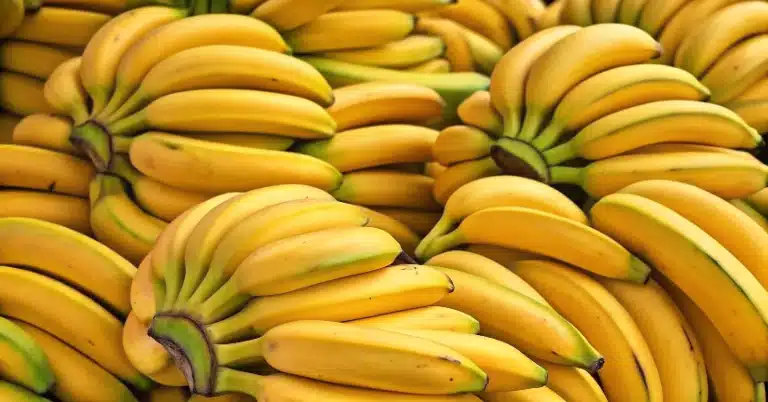Every baker knows the secret to amazing banana bread: overripe bananas. Those bananas that look old are actually perfect for baking. My grandmother taught me this years ago, showing me how they make the best banana bread.
Baking with ripe bananas is more than a trick—it’s science. As bananas get older, they change in a way that makes them perfect for baking. The darker they are, the sweeter and more complex their flavor becomes. This turns a simple banana bread into a delicious treat.
Table of Contents
Table of Contents
The Science Behind Overripe Bananas for Banana Bread
The banana ripening process is a fascinating journey of chemical transformation. It turns an ordinary fruit into a baker’s delight. As bananas age, they undergo remarkable changes that dramatically impact their flavor, sweetness, and baking chemistry.
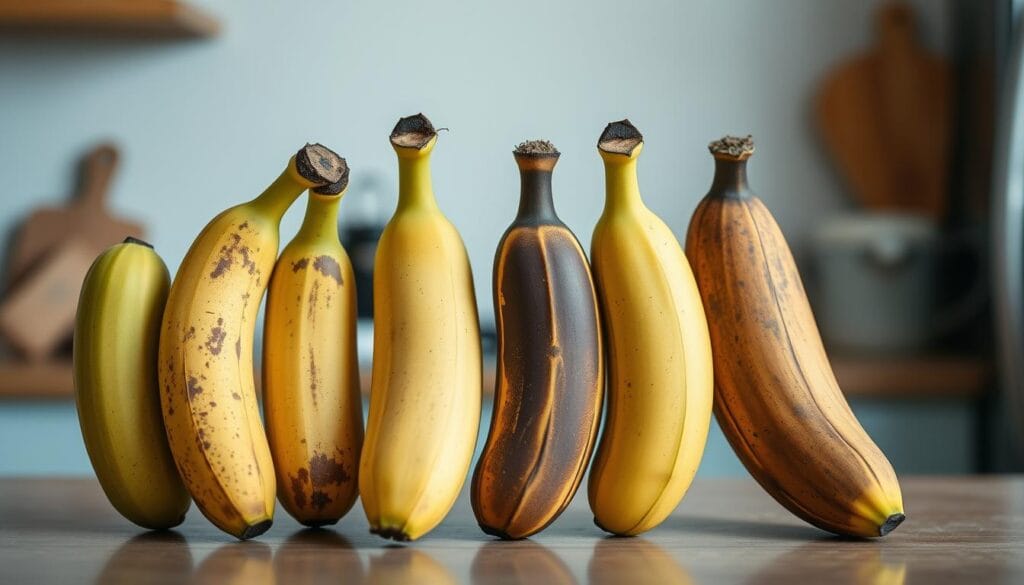
Understanding the science of banana ripening reveals why older bananas become perfect for baking. The transformation involves complex biochemical processes. These processes break down starches and develop natural sugars.
Chemical Changes During Ripening
During the ripening process, bananas experience several key transformations:
- Chlorophyll breaks down, changing the peel from green to yellow to brown
- Ethylene gas accelerates the ripening mechanism
- Enzymes actively convert complex carbohydrates into simple sugars
Natural Sugar Development
As bananas ripen, they develop natural sugars that make them increasingly sweet. The starch content gradually decreases while sugar concentration increases. This creates a more intense and complex flavor profile.
Starch to Sugar Conversion
The most critical aspect of banana ripening for baking is the starch-to-sugar conversion. Enzymes gradually break down resistant starches, transforming them into simple, easily digestible sugars. This process not only enhances sweetness but also improves the moisture content crucial for creating delectable baked goods.
“Overripe bananas are a baker’s secret weapon for creating incredibly moist and flavorful treats.”
Global statistics highlight the importance of understanding banana ripeness: Nearly black bananas are considered the preferred choice for banana bread, offering maximum moisture and sweetness. Interestingly, approximately 40% of home bakers now recognize the value of using extremely ripe bananas in their baking.
Why Are overripe bananas Better for Banana Bread?
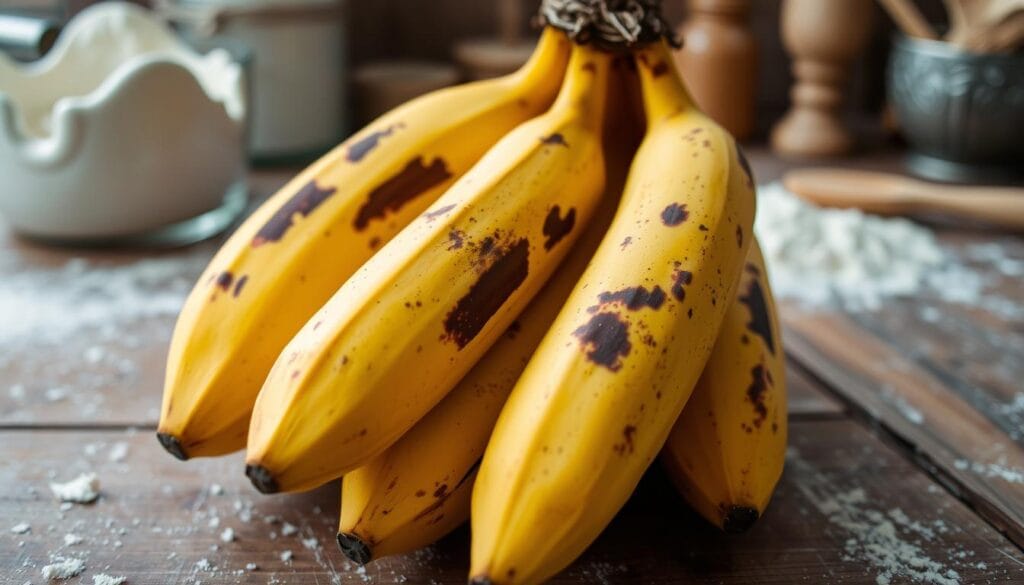
Bakers know the secret to an exceptional banana bread recipe lies in selecting the right overripe bananas. Not all bananas are created equal when it comes to creating the perfect loaf.
Ripe bananas are a flavor enhancer that transforms an ordinary banana bread into a mouthwatering treat. As bananas age, they undergo remarkable chemical changes that make them ideal for baking.
- Bananas with brown and black peels provide the most intense flavor
- Soft, easily mashed bananas create a smoother batter
- Increased sugar content leads to better caramelization
The ripening process dramatically improves banana bread quality. Yellow bananas with brown spots are particularly perfect for baking, offering an optimal balance of sweetness and moisture.
“The darker the banana, the more complex and rich the flavor becomes” – Professional Bakers’ Insight
When selecting bananas for your banana bread recipe, look for these characteristics:
| Banana Color | Baking Suitability | Flavor Intensity |
|---|---|---|
| Green | Poor | Minimal |
| Yellow with Green Tips | Not Recommended | Weak |
| Yellow with Brown Spots | Excellent | Medium |
| Brown/Black Peel | Perfect | Maximum |
Overripe bananas are not just a baking shortcut—they’re a culinary secret weapon that guarantees a moist, flavorful banana bread every time.
Identifying Perfectly Overripe Bananas for Banana Bread
Choosing the right bananas is key to making amazing banana bread. Knowing how bananas ripen is essential for great baking.
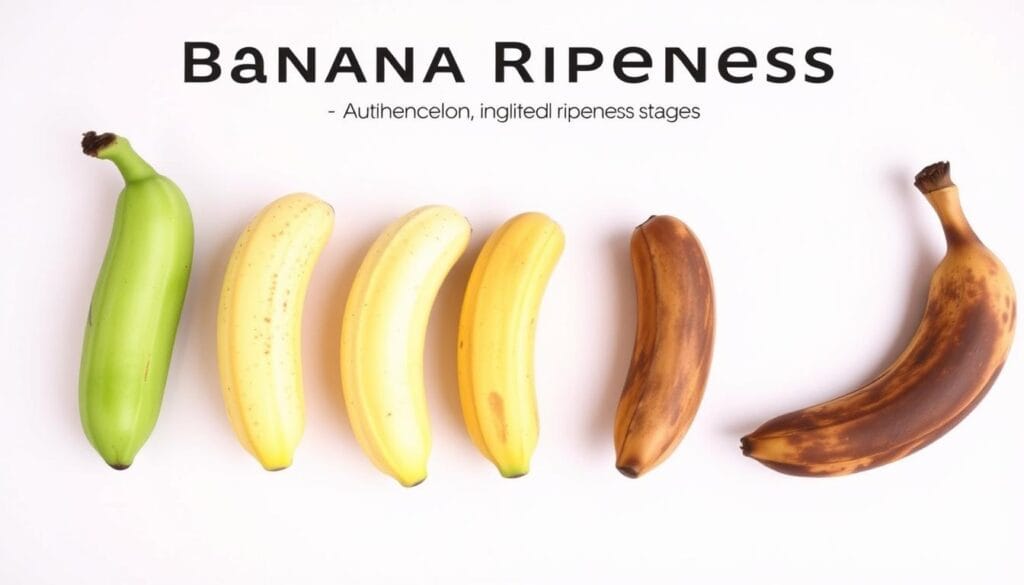
For baking, you need to watch how bananas change. Not all bananas are good for banana bread.
Decoding Banana Color Changes
The banana’s color shows its ripeness and taste. Here’s what to look for:
- Yellow with Green Tips: Underripe and starchy – not ideal for baking
- Bright Yellow: Slightly sweet but lacks intense banana flavor
- Yellow with Brown Spots: Prime baking condition – maximum sweetness
- Brown/Black Speckled: Perfect for banana bread – extremely soft and sweet
Identifying Prime Baking Bananas
The best bananas for baking are soft, like pudding. They should feel soft but not mushy. Brown spots mean they’re sweet and ready for baking.
Recognizing Overripe Bananas for banana bread
Very dark bananas are great for baking, but be careful. Bananas that smell fermented or show mold should be thrown away. A slight alcohol smell means they’re too ripe for baking.
“The secret to incredible banana bread lies in selecting bananas at their flavor peak.” – Professional Baker
Pro tip: For the best banana bread, pick bananas with lots of brown speckling. They’ll add sweetness and moisture.
Moisture Content and Texture Benefits of Overripe Bananas
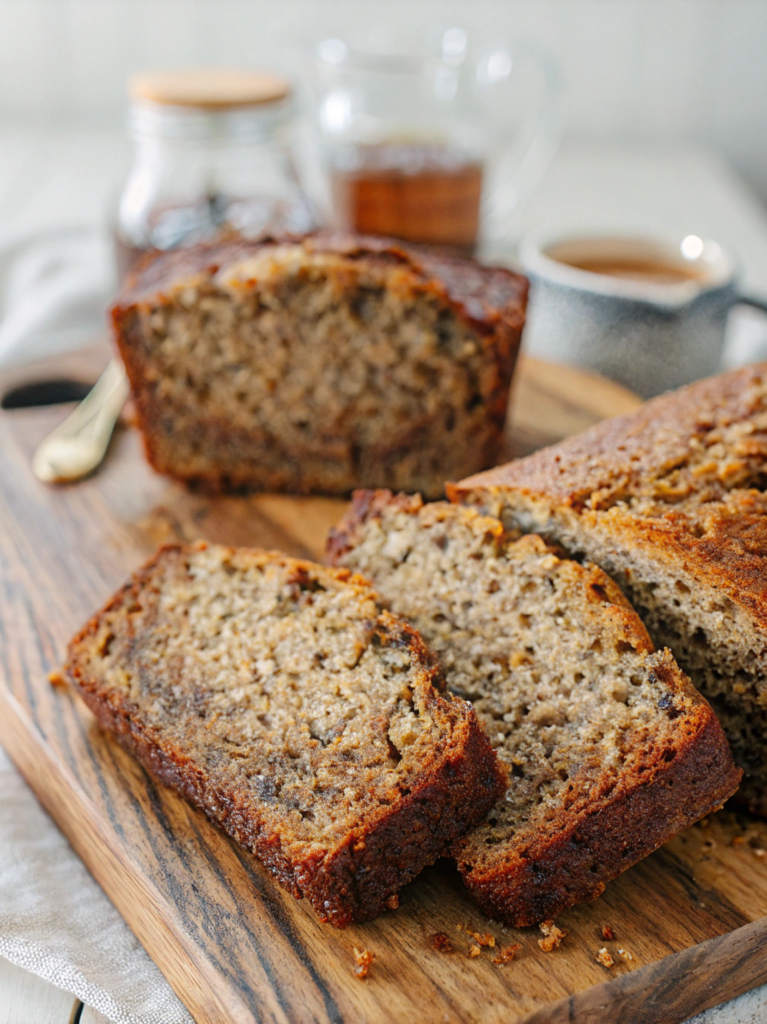
Baking with ripe bananas makes a regular bread recipe into a moist banana bread treat. The secret is the moisture in overripe bananas. This makes the bread tender and soft, just what home bakers love.
When bananas are at their peak ripeness, they go through amazing changes. These changes make the bread texture better. The extra water in them makes the bread moist and keeps it soft and tasty.
- Overripe bananas contain up to 20% more moisture than yellow bananas
- Natural sugars help retain water during the baking process
- Softer bananas blend more seamlessly into bread batter
The magic of moist banana bread is at the molecular level. As bananas ripen, their starches break down. This releases more liquid that mixes well with other ingredients. This natural moisture transformation means you’ll need less added liquid in your recipe.
“The riper the banana, the more luxurious your bread will be” – Professional Baking Experts
Bakers get amazing results by choosing bananas with deep brown or even blackened peels. These bananas add extra moisture and natural sugars. This makes the bread’s flavor more complex and rich.
Natural Sweetness: Overripe Bananas Reduce Sugar in Banana Bread
Sweeter bananas are the secret to making delicious banana bread with less sugar. As bananas ripen, they become sweeter. This means you need less sugar in your banana bread recipe.
The magic of natural sugars in overripe bananas changes baking. When bananas turn from green to dark brown or black, they become sweeter. This is because their starch turns into sugar.
Sugar Content Transformation
Ripe bananas are great for baking. They can have up to 20% natural sugar. This lets bakers use less added sugar in their recipes.
- Overripe bananas can reduce added sugar by 1/4 to 1/3 cup
- Dark brown to black peels show they are at their sweetest
- Softened texture makes mashing easier for banana bread recipes
How Overripe Bananas Improve Moisture and Sweetness
“The riper the banana, the sweeter the bread” – Baking Wisdom
Here are tips for using natural sweetness in your banana bread:
- Taste the batter and adjust sugar as needed
- Use a mix of brown and white sugar for the best flavor
- Try using fully ripened bananas for the most natural sweetness
By using the natural sugars in overripe bananas, you can make healthier banana bread. It will be sweeter and need less added sugar.
Enhanced Flavor Profile of Overripe Bananas for banana bread
Overripe bananas are a secret weapon in making amazing banana bread. As bananas age, they change in a way that boosts their flavor. The banana taste gets stronger and more complex, making them a treasure for bakers.
The science behind this flavor change is really cool. When bananas ripen, several important things happen:
- Enzymes break down cell walls
- Pectin structures soften
- Natural sugars caramelize
- Aromatic compounds intensify
Bakers love overripe bananas for their special benefits. These bananas can have up to 80% more sugar than unripe ones. This means they add deeper, richer flavors to baked goods.
“The darker the banana, the more intense the flavor” – Baking Experts
Color changes show how the flavor is getting better. Bananas turning from yellow to brown are at their best for baking. The brown spots mean the bananas are sweeter and more complex.
| Banana Ripeness Stage | Flavor Characteristics | Baking Suitability |
|---|---|---|
| Bright Yellow | Mild, subtle banana taste | Limited flavor intensity |
| Yellow with Brown Spots | Rich, deep banana flavor | Ideal for banana bread |
| Mostly Brown | Extremely sweet, concentrated flavor | Perfect for baking |
Impact on Bread Structure and Density
Banana bread’s magic starts with the mix of proteins and starches in overripe bananas. The baking science behind a moist banana bread is all about how these molecules work together. It turns a simple recipe into something truly special.
Protein and Starch Interactions
When overripe bananas mix with flour, a fascinating process happens. The soft fruit changes how proteins and starches interact, affecting the bread’s texture. The enzymes in ripe bananas break down carbs, making the batter more even and the gluten stronger.
- Increased enzyme activity in overripe bananas
- Enhanced protein modification during mixing
- Improved moisture distribution throughout the batter
Texture Development Mechanics
The science of banana bread’s texture focuses on moisture and protein. Overripe bananas make the bread dense and moist, with a strong structure. Their sugar helps with caramelization and browning, adding a deep flavor.
“The secret to perfect banana bread lies in understanding the transformative power of ripened fruit” – Baking Science Experts
| Banana Ripeness Stage | Structural Impact | Texture Characteristics |
|---|---|---|
| Slightly Ripe | Minimal protein interaction | Firmer, less cohesive texture |
| Overripe | Maximum protein modification | Soft, dense, uniform crumb |
Knowing these chemical changes helps bakers make banana bread with great structure and flavor. The journey from ingredients to a perfect loaf shows the amazing science of baking.
Freezing and Storing Overripe Bananas for Baking
Learning how to ripen bananas can change your baking game. Knowing how to store and ripen bananas right means you’ll always have the best fruit for baking.
Temperature is key in ripening bananas. The best storage temperature is between 60 and 70 degrees Fahrenheit. Bananas usually ripen in about six days at room temperature, making them great for banana bread.
- Keep bananas away from direct sunlight to control ripening speed
- Store at room temperature for optimal ripening
- Avoid refrigerating unripe bananas
To speed up the ripening process, try these tips:
- Place bananas in a paper bag with an apple or another ripe banana
- Wrap banana stems individually with plastic wrap to slow down ripening
- Keep bananas separate from other ethylene-producing fruits like avocados and tomatoes
“The secret to perfect banana bread lies in understanding the art of banana ripening” – Baking Enthusiasts Magazine
Pro tip for baking with ripe bananas: Freeze overripe bananas for up to six months. Peel and store them in airtight bags, so you always have ripe bananas for your recipes.
Refrigeration can be tricky. It keeps bananas for an extra one to two days. But, it can cause damage if it gets too cold. For the best results, use refrigeration sparingly and only with already ripe bananas.
Common Myths About Using Overripe bananas for banana bread
Baking with ripe bananas often leads to misconceptions. These can stop home bakers from making tasty banana bread. Let’s clear up some common myths about overripe bananas.
- Myth: Brown bananas are rotten and unsafeDark brown or even black bananas are great for banana bread. They have more sugar and are softer, making them perfect for baking.
- Myth: Freezing changes banana baking propertiesFreezing ripe bananas doesn’t hurt their baking quality. In fact, frozen overripe bananas are a great addition to banana bread.
- Myth: Banana bread requires expensive ingredientsYou don’t need fancy items for delicious banana bread. Simple, wholesome ingredients can turn overripe bananas into a tasty treat.
“The ripest banana tells the sweetest story in baking” – Unknown Baker
Overripe bananas are not just tasty. They also have more antioxidants and plant compounds. This makes baking with ripe bananas not only delicious but also healthier.
Knowing these myths lets home bakers use their overripe bananas confidently. They can make amazing banana bread that’s both nutritious and satisfying.
Quick-Ripening Methods and Techniques
Baking with ripe bananas doesn’t always mean waiting days. Home bakers can speed up the ripening process. This turns yellow bananas into perfect bread ingredients.
There are clever ways to quickly ripen bananas. These methods improve flavor and texture. Let’s look at two effective ways to get bananas ready for baking.
Oven-Roasting Method
Roasting bananas in the oven is a quick fix for bakers. Here’s how to do it:
- Preheat oven to 300°F (150°C)
- Place unpeeled bananas on a baking sheet
- Roast for 15-20 minutes until skin turns black
- Remove and let cool before mashing
Oven roasting has several benefits:
| Benefit | Detail |
|---|---|
| Ripening Time | Less than 30 minutes |
| Flavor Concentration | Caramelizes natural sugars |
| Storage | Roasted bananas can be frozen up to 6 months |
Paper Bag Acceleration Technique
Another natural method uses ethylene gas to speed up ripening:
- Place bananas in a paper bag
- Add a ripe apple or banana
- Fold bag top closed
- Let sit at room temperature for 24-48 hours
“The secret to perfect banana bread is understanding how to transform ordinary bananas into flavor-packed ingredients.” – Baking Experts
For the best banana bread, watch the ripening closely. This ensures the bananas are soft and sweet.
Conclusion
Unlocking the magic of a perfect banana bread recipe starts with understanding the power of overripe bananas. These brown-speckled fruits are not past their prime—they’re baking gold. When bananas develop dark spots, their natural sugars concentrate, creating an unparalleled depth of flavor.
This transformation is simple yet remarkable. As bananas ripen, their starches convert to sugars, softening the fruit and intensifying its sweetness. This means you can reduce added sugar in your recipe while maintaining incredible moisture and taste.
Home bakers who embrace overripe bananas discover a secret weapon for creating incredibly rich, tender banana bread. This bread keeps everyone coming back for another slice.
Next time you spot those spotted bananas on your kitchen counter, resist the urge to discard them. Instead, view them as an opportunity for baking excellence. By understanding the ripening process, you’ll elevate your banana bread from good to extraordinary.
This proves that in baking, patience and knowledge can turn seemingly ordinary ingredients into something truly spectacular.
FAQs For Overripe bananas for banana bread
1. Why are overripe bananas best for banana bread?
Overripe bananas are sweeter, softer, and moister than less ripe ones. Their starch converts to sugar, enhancing sweetness and flavor while improving bread texture.
2. How ripe should bananas be for banana bread?
Bananas with brown or black speckles are ideal. Fully brown or black bananas offer maximum sweetness and moisture, making them perfect for baking.
3. Can I use frozen bananas for banana bread?
Yes! Frozen overripe bananas work wonderfully. Thaw and drain excess liquid before using them in your recipe.
4. How can I quickly ripen bananas for banana bread?
Place bananas in a paper bag with a ripe apple or bake them at 300°F for 15-20 minutes to speed up ripening.
5. Do overripe bananas reduce the need for added sugar?
Yes! Overripe bananas are naturally sweet, allowing you to reduce the added sugar in your recipe by up to 1/3 cup.
6. How do overripe bananas affect banana bread texture?
Overripe bananas add extra moisture, resulting in a softer, denser texture. Their sugars also help with caramelization during baking.
7. What should I do with leftover overripe bananas?
Peel and freeze them for up to six months. Use them later for banana bread, smoothies, or other baked goods.
8. Can I use bananas that smell like alcohol?
No, bananas with a strong alcohol smell or visible mold are too ripe and should be discarded.
9. How do I store overripe bananas for baking?
Keep them at room temperature until fully ripened. You can also freeze peeled bananas for later use.
10. What makes overripe bananas a healthy choice for baking?
Overripe bananas are rich in antioxidants and natural sugars, reducing the need for refined sugar while adding nutritional benefits.

